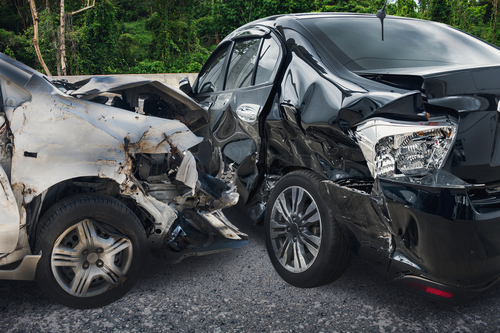 Even a seemingly minor collision can result in serious, long-term injuries in car accidents. While some of the most common injuries include head, neck, and spinal trauma. Many accident victims often report severe knee injuries in collisions. Call our personal injury attorneys if you were seriously injured in a car accident.
Even a seemingly minor collision can result in serious, long-term injuries in car accidents. While some of the most common injuries include head, neck, and spinal trauma. Many accident victims often report severe knee injuries in collisions. Call our personal injury attorneys if you were seriously injured in a car accident.
These types of injuries occur when a strong external force is suddenly placed on the knee. That may cause extensive damage to the bones, ligaments, cartilage, and more.
The most common types of knee injuries sustained in car wrecks include:
- Kneecap Fractures – Kneecap fractures occur when the patella is cracked, broken, or shattered. High-energy impacts, such as car accidents, cause these fractures.
- Thighbone Fractures of the Knee – Like kneecap fractures, thighbone fractures are the result of high-energy impacts. In this case, the fracture can extend from the kneecap into the lower femur.
- Shinbone Fractures of the Knee – Shinbone fractures, like kneecap and thighbone fractures, can happen during a high-energy impact such as a car collision. In this case, the fracture can extend into the upper shinbone.
- Knee Dislocation – Dislocations happen when the bones in the knee are either partially or entirely out of place. A high-impact car collision could result in a knee dislocation in people with usually healthy knee structures.
- Anterior Cruciate Ligament (ACL) Injuries – ACL injuries are commonly known as sports injuries. However, if this ligament is subject to high-energy trauma — such as within a car accident — it is prone to fracturing or tearing.
- Posterior Cruciate Ligament (PCL) Injuries – PCL injuries occur when the knee suffers from a blow to the front while in a bent position. These ligament injuries most commonly occur during vehicle collisions.
- Collateral Ligament Injuries – Most often caused by a direct blow to the outside of the knee. These injuries involve the ligaments on the sides of your knee. Collateral ligament injuries can occur during a car accident if a driver is rear-ended by another car at high speed.
- Meniscal Tears – Meniscus tissue provides the bones in your knees with the cushion they need to move and flex comfortably. The meniscus can be fragile, and a simple twist, turn, or blow may cause it to tear.
- Tendon Tears – Tendon tears most commonly occur when the knee is subjected to a direct, front-facing blow. The high impact of the trauma can cause the tendon to stretch, fracture, or completely break.
After a car accident, drivers need to be aware of any knee-injury symptoms. These include pain, popping sounds, weakness, swelling, immobility, and limping. If you are experiencing any of these symptoms after a car accident, you must seek medical attention immediately.
Contact a New York Car Accident Attorney
Did you suffer a severe knee injury in a car accident that was not your fault? If so, you could be entitled to compensation from the person or party responsible. Contact a New York car accident lawyer at Hach & Rose, LLP by calling (212) 779-0057. Fill out a contact form or chat with us live online. Our team will sit down with you and discuss your knee injury and how we can help you get the justice and fair compensation you’re owed.
